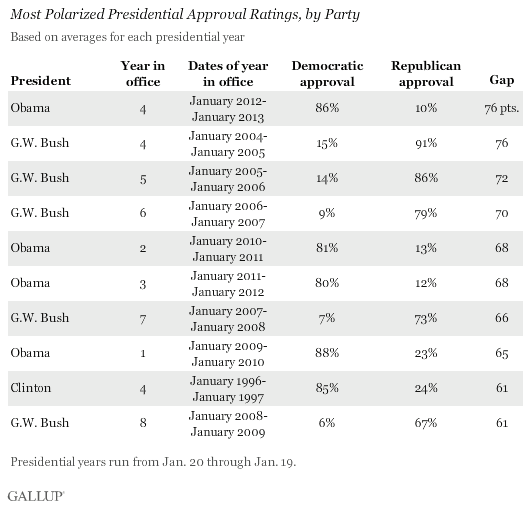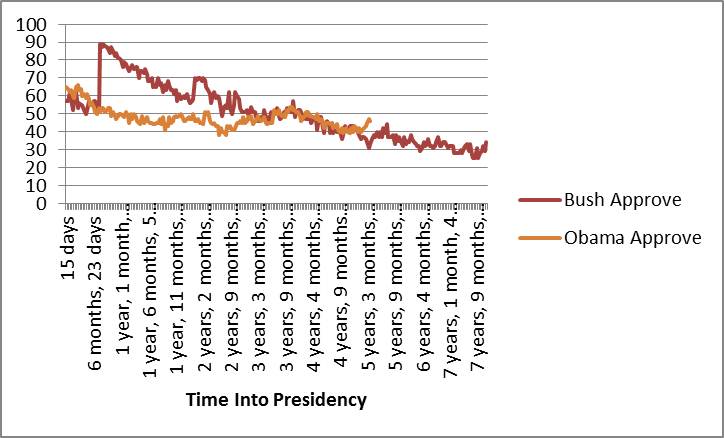Three new national polls came out recently showing President Obama’s approval ratings falling to the low 40% range, which puts them at or near the lowest of his presidency. The drop in support came in the wake of a series of bad news, including the VA scandal, the ongoing IRS controversy and most recently, the unexpected surge by the Isis terrorists in Iraq. This drop led to the predictable overreaction from the punditocracy. NBC’s Chuck Todd declared that the numbers “are a disaster for the President.” Similarly, Ron Fournier tweeted: “#Obama getting dangerously close to failed presidency territory.”
However, while the numbers aren’t great news for Obama, it is useful to put them in their historical context. First, as the PlumLine’s Greg Sargent points out, this is not new polling territory for Obama; his approval has dropped this low in some polls in previous months. And, while it is typical for pundits like Todd to attribute changes in approval ratings to particular events, such as the deteriorating conditions in Iraq, research shows that presidential approval is also driven by what we might call structural factors. One of these is time in office. In his seminal work on the American Presidency, political scientist Richard Neustadt noted that “there is a certain rhythm in the modern presidency.” While Neustadt referred primarily to a president’s learning curve while in office, his observation pertains to how the public perceives the President, as gauged in approval polls, as well. Thus Paul Brace and Barbara Hinckley, in their study of the factors influencing presidential approval, suggest that once you control for events, approval ratings following a set dynamic that reflects the length of time a president has been in office. In this regard, it is interesting to compare Obama’s approval with that of his predecessor, George W. Bush, at similar times in their presidencies. Martina Berger put together the following comparison based only on Gallup Poll surveys:
We can see that five years into their presidencies, their approval ratings follow similar downward trajectories – indeed, if one removes the impact of the Iraq war on Bush’s approval, the trend lines are almost identical throughout their presidencies. This partly reflects, I think, the natural rhythms in approval associated with a president’s time in office in the modern context. But it also is an indication of just how thoroughly Americans are sorted along party lines. As I’ve noted elsewhere, presidents Bush and Obama are the two most polarizing presidents in the modern era in terms of the partisan division in their levels of support – as this table shows, their sources of support are almost mirror images:
 We should be careful not to read this poll as evidence that Americans are highly polarized, however. Instead, it reflects the fact that their choices – in this case, whether to approve or disapprove of a president – are perceived to be polarized. Even a closely divided, mostly moderate public – which I have argued elsewhere is the best characterization of the current distribution of Americans’ public opinion – will appear to be divided if only given two extreme choices in a survey. Put another way, we would expect to get these polling results even if most Americans place themselves close to the middle of the ideological spectrum, with perhaps a slight lean in either direction.
We should be careful not to read this poll as evidence that Americans are highly polarized, however. Instead, it reflects the fact that their choices – in this case, whether to approve or disapprove of a president – are perceived to be polarized. Even a closely divided, mostly moderate public – which I have argued elsewhere is the best characterization of the current distribution of Americans’ public opinion – will appear to be divided if only given two extreme choices in a survey. Put another way, we would expect to get these polling results even if most Americans place themselves close to the middle of the ideological spectrum, with perhaps a slight lean in either direction.
The bottom line is that we should not be surprised by the downward trajectory of Obama’s public support. Nor should we overreact to the latest number. It likely reflects the interaction of a highly-sorted electorate and the rhythm of approval associated with a president’s time in office. This is not to say that Obama’s approval will necessarily track Bush’s for the remainder of the President’s time in office, although it might. It does suggest, however, that it is driven by factors that are largely out of the President’s control. And, as I will discuss in posts to come, it does not bode all that well for Democrat’s electoral prospects in the upcoming midterms.

